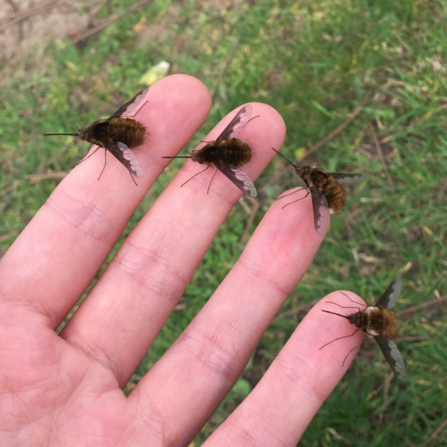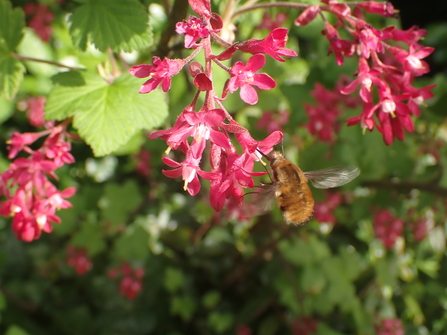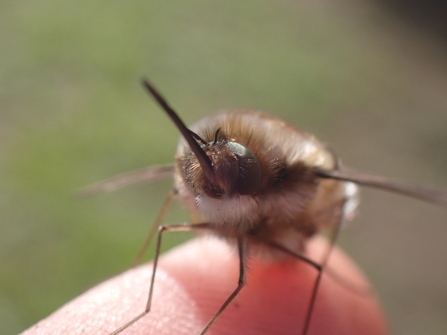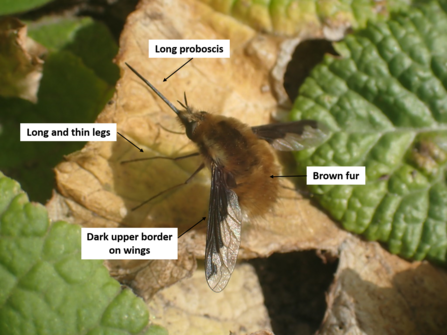The dark-edged bee-fly (Bombylius major) is aptly named, being furry with a dark upper border on its wings, and can be encountered in Cumbria.
A fly in disguise - meet the dark-edged bee-fly
Dark-edged bee-fly on bittercress. Photo Charlotte Rankin.

Dark-edged bee-flies resting on finger tips, Photo Charlotte Rankin.
A fly in disguise, the dark-edged bee-fly is a curious insect both in its appearance and lifecycle. Using their long and spear-like ‘tongue’ (known as a proboscis), bee-flies extract nectar and pollen from flowers for fuel. Bee-flies do this by hovering over flowers and using their proboscis with impeccable precision, even on the smallest of flowers.
Given their long tongue, dark-edged bee-flies visit plants with deep flowers such as pulmonaria, grape hyacinth, flowering currant, common primrose and bugle. With this hovering comes a high-pitched buzz, so you may hear a bee-fly before you see it!

Dark-edged bee-fly on flowering currant. Photo Charlotte Rankin.
So what makes a bee-fly a fly? Furry with a loud buzz, dark-edged bee-flies are easily mistaken for a bumblebee. Unlike bees, bee-flies and other flies only have one pair of wings, shorter antennae, and large eyes that cover most of the face.
While bees do have a proboscis, though perhaps less impressive, this is retractable unlike that of bee-flies. Four times as long as their head, bee-flies wear their proboscises proudly! You can tell the difference between females and males by their eyes: in males, the eyes meet at the top of the head.

Dark-edged bee-fly close-up. Photo Charlotte Rankin.
But don’t be fooled! Behind this cute appearance is a more sinister way of life. The dark-edged bee-fly belongs to a group of flies (Genus Bombylius) who are fantastic bumblebee mimics and clever parasites of solitary bee nests. There are four of these species in Britain and the dark-edged bee-fly is a common species in Cumbria.
Bee-flies spend a lot of their time at the nest sites of mining bees. Mining bees dig burrows into the ground, laying their eggs within and provisioning each egg with pollen and nectar. Bee-flies flick their eggs towards the nests of mining bees and have a clever trick up their sleeve to ensure their offspring’s survival.
Female dark-edged bee-fly coating her eggs in soil. Video Charlotte Rankin.
Before they flick their eggs, females first coat the eggs in soil or sand by rubbing the end of their abdomen into earth. This provides her eggs with protection against desiccation and to also perhaps add camouflage. Once the bee-fly egg hatches, the grub will move into a nearby nest burrow and feed on the mining bee grub.
Fast forward to the following spring, the bee-fly will emerge as an adult and the lifecycle will start once again. While rather gruesome, this relationship has occurred for many millennia. It adds another fascinating dimension to the insect world and the presence of bee-flies is a sign of good host populations.

How to identify a dark-edge bee-fly. Photo Charlotte Rankin.
Found in gardens and parks, keep an eye out for these fluffy nest usurpers from March through to June. April is a particularly good time to spot them. You’ll find bee-flies investigating nest sites, feeding on flowers nearby, or basking on bare ground to warm up on chillier days.
You can attract bee-flies into your garden by planting their favourite forage such as common primrose, pulmonaria and grape hyacinth. Allowing dandelions to grow on your lawn also makes a fantastic early-flowering resource for pollinators, particularly at a time when not many plants are in flower.
Dark-edged Bee-fly preparing for take off. Video Charlotte Rankin.
Thanks to funding from the Green Challenge Recovery Fund, Planting for Pollinators will be restoring and creating wildflower-rich habitat for pollinators such as bee-flies across north and west Cumbria.
Together with communities, landowners and managers, over 50 sites will be improved for pollinators. Keep an eye on our project webpage for opportunities to get involved in pollinator recording, identification and wildflower planting.
Blog by Charlotte Rankin, Planting for Pollinators Conservation Officer

